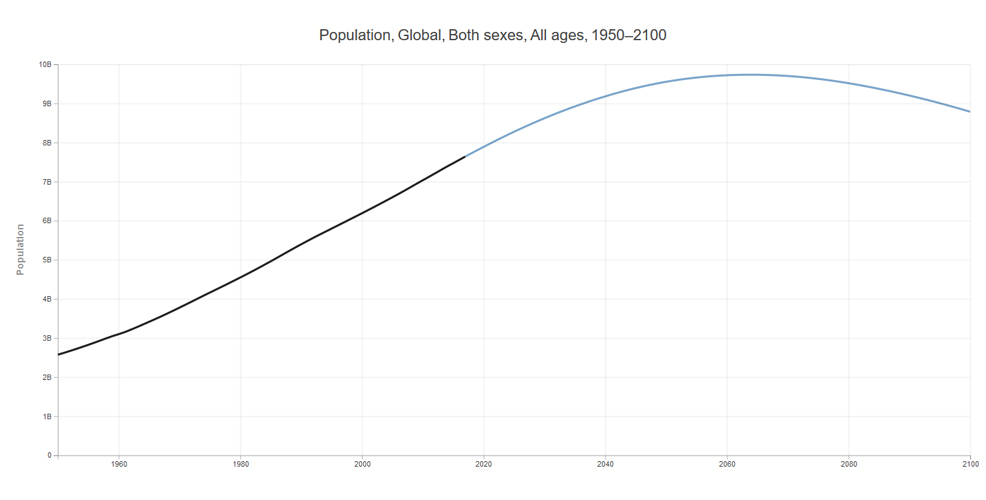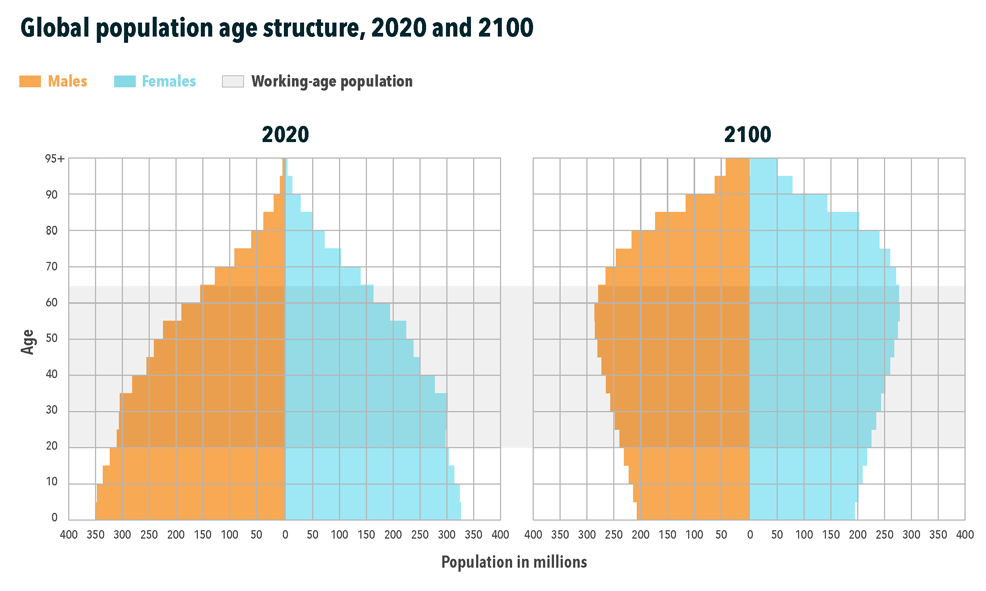
15th July 2020 World population expected to peak by 2064 A new study, published this week in The Lancet, concludes that the global population is likely to peak in 2064 at 9.7 billion and fall to 8.8 billion by century's end. The report foresees major shifts in geopolitical power – producing a more multi-polar world – with 23 countries seeing their populations shrink by more than half as a result of declining fertility rates. Liberal immigration policies could help to maintain population sizes and economic growth, the authors suggest.
Improved access to modern contraception and the education of girls and women are generating widespread, sustained declines in fertility – meaning that the world's population in 2100 could be as much as 2 billion lower than some previous forecasts, according to a new study. The modelling research uses data from the latest Global Burden of Disease Study – a collaboration of 3,600 researchers around the world – to project the likely trends in future global, regional, and national populations. Using novel methods for long-term forecasts of mortality, fertility, and migration, the authors estimate that by 2100, 183 of 195 countries will have total fertility rates (the average number of children a woman delivers over her lifetime) below the replacement level of 2.1 births per woman. This means that populations in those countries will fall, unless low fertility is compensated by immigration. A team from the Institute for Health Metrics and Evaluation (IHME) at the University of Washington's School of Medicine published the study, which appears in the prestigious medical journal, The Lancet. The new population forecasts are in contrast to projections of "continuing global growth" by the United Nations Population Division, and highlight the huge challenges to economic growth of a shrinking workforce, high burden on health and social support systems of an aging population, and impacts on global power linked to shifts in world population. The new research also predicts huge shifts in the global age structure, with an estimated 2.4 billion people aged over 65 years globally in 2100, compared with just 1.7 billion under 20 years – underscoring the need for liberal immigration policies in countries with declining working age populations.
"Continued global population growth through the century is no longer the most likely trajectory for the world's population," says Christopher Murray, Director of the IHME, who led the research. "This study provides governments of all countries an opportunity to start rethinking their policies on migration, workforces and economic development to address the challenges presented by demographic change." "The societal, economic, and geopolitical power implications of our predictions are substantial," says IHME Professor Stein Emil Vollset, first author of the paper. "In particular, our findings suggest that the decline in the numbers of working-age adults alone will reduce GDP growth rates that could result in major shifts in global economic power by the century's end. Responding to population decline is likely to become an overriding policy concern in many nations, but must not compromise efforts to enhance women's reproductive health or progress on women's rights." Dr Richard Horton, Editor-in-Chief of The Lancet, adds: "This important research charts a future we need to be planning for urgently. It offers a vision for radical shifts in geopolitical power, challenges myths about immigration, and underlines the importance of protecting and strengthening the sexual and reproductive rights of women. The 21st century will see a revolution in the story of our human civilisation. Africa and the Arab World will shape our future, while Europe and Asia will recede in their influence. By the end of the century, the world will be multipolar, with India, Nigeria, China, and the US the dominant powers. This will truly be a new world; one we should be preparing for today."
Worldwide, total fertility rates (TFR) are predicted to steadily decline – from 2.37 today, to 1.66 in 2100 – well below the 2.1 minimum rate considered necessary to maintain population numbers (replacement level). Rates are expected to reach 1.2 in Italy and Spain, and as low as 1.17 in Poland. Even slight changes in TFR translate into large differences in population size for countries below the replacement level. Increasing the figure by as little as 0.1 births per woman is equivalent to around 500 million more individuals on the planet in 2100. Much of the anticipated fertility decline is predicted in high-fertility countries, particularly those in sub-Saharan Africa where rates are expected to fall below the replacement level for the first time – from an average of 4.6 births per woman today, to just 1.7 by 2100. In Niger, where the fertility rate is currently the highest in the world – with women giving birth to an average of seven children – the rate is projected to decline to around 1.8 by 2100. Nevertheless, the population of sub-Saharan Africa is forecast to triple over the next 80 years, from an estimated 1.03 billion in 2020 to 3.07 billion in 2100 – with death rates lowering and an increasing number of women entering reproductive age. North Africa and the Middle East is the only other region predicted to have a larger population in 2100 (978 million) than in 2020 (600 million). Many of the fastest-shrinking populations will be in Asia and central/eastern Europe. Populations are expected to more than halve in 23 countries and territories, including Japan (from around 128 million people in 2020 to 60 million in 2100), Thailand (71 to 35 million), Spain (46 to 23 million), Italy (61 to 31 million), Portugal (11 to 5 million), and South Korea (53 to 27 million). An additional 34 countries are expected to have population declines of 25 to 50%, including China (1.4 billion in 2020 to 732 million in 2100). "This study is a thought-provoking contribution to the very lively, ongoing debate around the world's demographic trajectory and its impact on our common future," said Dr. Natalia Kanem, Executive Director of the United Nations Population Fund. "While the models, projections and time frames of different institutions may vary, all signs point towards declining global fertility. Protecting the reproductive rights and choices of women will be crucial in this demographic transition."
As fertility falls and life expectancy increases worldwide, the number of children under 5 years old is forecasted to decline by 41% – from 681 million in 2020 to 401 million in 2100, whilst the number of individuals older than 80 years is projected to increase six-fold – from 141 million to 866 million. Meanwhile, the global ratio of non-working adults to workers – around 0.8 in 2020 – is projected to reach 1.16 in 2100 if labour force participation by age and sex does not change. "While population decline is potentially good news for reducing carbon emissions and stress on food systems, with more old people and fewer young people, economic challenges will arise as societies struggle to grow with fewer workers and taxpayers, and countries' abilities to generate the wealth needed to fund social support and health care for the elderly are reduced," says Professor Vollset. The study examined what sort of economic impact could be expected with fewer working-age adults. While China is set to replace the USA in 2035 with the largest total gross domestic product (GDP) globally, rapid population decline from the 2050s onward will curtail economic growth. As a result, the USA is expected to reclaim its top spot by 2098, if immigration continues to sustain the US workforce. Although numbers of working-age adults in India are projected to fall from 762 million in 2020 to around 578 million in 2100, it is expected to be one of the few – if only – major power in Asia to protect its working-age population over the century. It will surpass China's workforce population in the mid-2020s (where the numbers of workers are estimated to decline from 950 million in 2020 to 357 million in 2100), rising up the GDP rankings from 7th to 3rd by 2050 and retaining that position until 2100. While the study ignores the potential impacts of climate change, sub-Saharan Africa is expected to become increasingly powerful on the geopolitical stage as its population rises. Nigeria is projected to be the only country among the world's 10 most populated nations to see its working-age population grow over the course of the century (from 86 million in 2020 to 458 million in 2100) – supporting rapid economic growth, and its rise in the GDP rankings from 23rd place in 2020 to 9th place in 2100. Meanwhile, the UK, Germany, and France are expected to remain in the top 10 for largest GDP worldwide by 2100. However, Italy (from 9th to 25th) and Spain (from 13th to 28th) are projected to fall substantially down the rankings, reflecting much greater population declines. The study suggests that falling populations could be offset by immigration, with countries that promote liberal immigration policies better able to maintain their population size and support economic growth, even in the face of declining fertility rates. The model predicts that some countries with fertility rates lower than replacement level – such as the USA, Australia, and Canada – will probably maintain their working-age populations through net immigration; although the authors note that there is considerable uncertainty about these future trends. "For high-income countries with below-replacement fertility rates, the best solutions for sustaining current population levels, economic growth, and geopolitical security are open immigration policies, and social policies supportive of families having their desired number of children," says Murray. "However, a very real danger exists that, in the face of declining population, some countries might consider policies that restrict access to reproductive health services, with potentially devastating consequences. It is imperative that women's freedom and rights are at the top of every government's development agenda." Professor Ibrahim Abubakar, University College London (UCL), UK, and Chair of Lancet Migration (who was not involved in the study), says: "Migration can be a potential solution to the predicted shortage of working-age populations. While demographers continue to debate the long-term implications of migration as a remedy for declining TFR, for it to be successful, we need a fundamental rethink of global politics. Greater multilateralism and a new global leadership should enable both migrant sending and migrant-receiving countries to benefit, while protecting the rights of individuals. Nations would need to cooperate at levels that have eluded us to date to strategically support and fund the development of excess skilled human capital in countries that are a source of migrants. An equitable change in global migration policy will need the voice of rich and poor countries. The projected changes in the sizes of national economies and the consequent change in military power might force these discussions. "Ultimately, if Murray and colleagues' predictions are even half accurate, migration will become a necessity for all nations and not an option. The positive impacts of migration on health and economies are known globally. The choice that we face is whether we improve health and wealth by allowing planned population movement or if we end up with an underclass of imported labour and unstable societies. The Anthropocene has created many challenges such as climate change and greater global migration. The distribution of working-age populations will be crucial to whether humanity prospers or withers."
Comments »
If you enjoyed this article, please consider sharing it:
|










